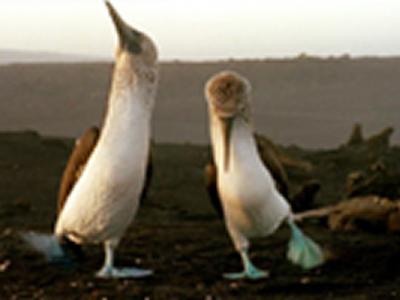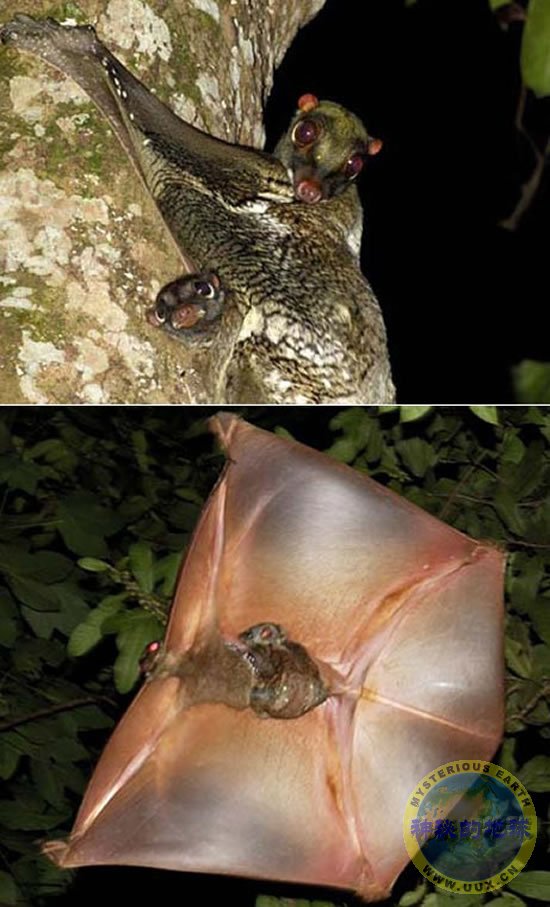Flying Lemurs Are Primates' Closest Kin

A Malayan colugo (top) carries its baby as it soars (bottom) through a Southeast Asian rain forest.
A new genetic study has found colugos, also known as flying lemurs, are primates' closest evolutionary cousins.
Scott Norris
for National Geographic News
November 1, 2007
A new genetic study claims to have settled a long-standing debate about which living group of mammals is most closely related to primates, which include monkeys, apes, and lemurs.
Our nearest nonprimate relatives are not tree shrews as once thought, researchers say—but another group of tree-dwelling mammals known as colugos, also known as flying lemurs.
Colugos are squirrel-size creatures that live in the rain forests of Southeast Asia. Only two species are known to exist.
Like flying squirrels, colugos have a wide membrane of skin between their limbs that, when fully extended, forms a kind of sail—allowing the animals to glide from tree to tree. (See an Asian primate, the tarsier, in flight.)
Previous DNA-based studies had suggested that primates, tree shrews, and colugos are closely related, forming a single evolutionary grouping that can be traced back to a common ancestral species. (Related news: "Fossils of 'Most Primitive Primate' Found Near Yellowstone" [February 1, 2007].)
But experts have continued to debate when and in what order the three groups diverged from one another.
The new study finds that the ancestors of tree shrews split off first, and then the primate and colugo lineages diverged. That means that colugos are primates' closest evolutionary cousins.
"Our molecular trees indicate that [primates and colugos] split approximately 86 million years ago, more than 30 million years before modern primates or colugos appear in the fossil record," said study co-author William Murphy.
Murphy and Jan Janečka, both of Texas A&M University in College Station, led the team of U.S. and German researchers who will publish their findings in tomorrow's issue of the journal Science.
Genetic Comparisons
The researchers performed a comparative analysis of rare genetic changes in the different mammal groups.
Seven such changes were found in common between primates and colugos, compared to only one between primates and tree shrews.
Such a discrepancy is likely only if primates and colugos had a more recent common ancestor not shared with tree shrews, the researchers said.
The primate-colugo relationship was also supported by a separate computer analysis, which compared differences in DNA sequences from fragments of 19 different genes totaling 14,000 base pairs of DNA.
Knowing the historical branching order of the three groups will help researchers reconstruct the genetic makeup of the ancestors to today's monkeys, apes, and humans.
"Our data suggest that a draft genome sequence of the colugo will be critical for understanding the changes in the genomes that led to early primates and provide a backdrop to those changes that ultimately led to humankind," Murphy said.
Eric Sargis of Yale University in New Haven, Connecticut, was not involved in the research.
"To understand the earliest evolutionary history of primates, it's essential to know which mammalian group primates diverged from most recently," he said.
Sargis said the new study is important, but it may not completely settle the debate over which mammal group is most closely related to primates.
One previous study examined an equally large genetic data set, he noted, but reached different conclusions.
"[Both studies] are part of the Mammal Tree of Life project, which will include analysis of more taxa and more data," Sargis said.
"The results of this larger collaboration may yield a different result than the one being published this week."
Shrewlike Ancestor
From the earliest days of biological classification, primates have been grouped together based on a number of shared characteristics: grasping hands, five fingers with nails rather than claws, and forward-facing eyes.
But the first primates may have had few obvious features in common with the apes and monkeys of today.
"The ancestors of early primates, colugos, and tree shrews did not resemble their modern forms," co-author Murphy said.
"The [physical] changes that led to the appearance of modern primates and flying lemurs happened millions of years after the genetic changes that divided the two lineages in the Cretaceous period."
The living creature that has retained the greatest physical similarity to the ancient common ancestor of all tree shrews, colugos, and primates may be the pentail tree shrew of Southeast Asia, Murphy noted.
The new evolutionary study also shows that the pentail tree shrew is the sole survivor of an ancient lineage long separated from other tree shrew species.
"We suggest that a global priority be placed on the conservation of the pentail tree shrew and its habitat," Murphy said, "as extinction of this one species would result in the loss of a 63-million-year-old lineage."












